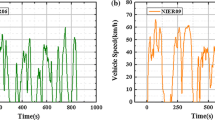Abstract
This study was focused on experimental comparisons of the effects of various vehicle certification modes on particle emission characteristics of light-duty vehicles with gasoline, diesel, LPG, and low-carbon fuels such as bio-diesel, bioethanol, and compressed natural gas, respectively. The particulate matter from various fueled vehicles was analyzed with the golden particle measurement system recommended by the particle measurement programme, which consists of CVS, a particle number counter, and particle number diluters. To verify particle number and size distribution characteristics, various vehicle emission certification modes such as NEDC, FTP-75, and HWFET were compared to evaluate particle formation with both CPC and DMS500. The formation of particles was highly dependent on vehicle speed and load conditions for each mode. In particular, the particle numbers of conventional fuels and low-carbon fuels sharply increased during cold start, fast transient acceleration, and high-load operation phases of the vehicle emission tests. A diesel vehicle fitted with a particulate filter showed substantial reduction of particulate matter with a number concentration equivalent to gasoline and LPG fuel. Moreover, bio-fuels and natural gas have the potential to reduce the particulate emissions with the help of clean combustion and low-carbon fuel quality compared to non-DPF diesel-fueled vehicles.
Similar content being viewed by others
References
Andersson, J., Wedekind, B., Hall, D., Stradling, R. and Barnes, C. (2001). DERT/SMMT/CONCAWE Particle Research Programme: Light-duty results. SAE Paper No. 2001-01-3577.
Andersson, J., Clarke, D. and Watson, J. A. (2004). UK Particulate Measurement Programme (PMP): A near US 2007 approach to heavy duty diesel particulate measurements — comparison with the standard European method. SAE Paper No. 2004-01-1990.
Andersson, J., Giechaskiel, B., Munoz-Bueno, R., Sandbach, E. and Dilara, P. (2007). Particle Measurement Programme (PMP) light-duty inter-laboratory correlation exercise (ILCE-LD) final report.
Choi, B. C., Yoon, Y. B., Kang, H. Y. and Lim, M. T. (2006). Oxidation characteristics of particulate matter on diesel warm-up catalytic converter. Int. J. Automotive Technology 7,5, 527–534.
Dockery, D., Pope, C. and Wu, X. (1993). An association between air pollution and mortality in six US cities. New England J. Med. 329,24, 1753–1759.
Fast Particulate Spectrometer User Manual (2008). http://www.cambustion.co.uk.
Giechaskiel, B., Munoz-Bueno, R., Rubino, L., Manfredi, U., Dilara, P., Santi, G. D. and Andersson, J. (2007). Particle size and number emissions before, during and after regeneration events of a Euro 4 DPF equipped light-duty diesel vehicle. SAE Paper No. 2007-01-1944.
Hagena, J. R., Filipi, Z. S. and Assanis, D. N. (2006). Transient diesel emission, analysis of engine operation during a tip-in. SAE Paper No. 2006-01-1151.
Kayes, D. and Hochgreb, S. (1999). Mechanism of particulate matter formation in spark-ignition engines. Environ. Sci. Technol., 33, 3957–3967.
Kittelson, D. B. (1998). Engines and nanoparticles: A review. J. Aerosol Sci. 29,5/6, 575–588.
Lee, J. W., Jung, Y. I., Jung, M. W., Cha, K. O., Kwon, S. I., Kim, J. C. and Park, S. (2008). Experimental investigation and comparison of nano-particle emission characteristics in light-duty vehicles for two different fuels. Int. J. Automotive Technology 9,4, 397–403.
Ostro, B. (1984). A research for a threshold in the relationship of air pollution to mortality: A reanalysis of London winters. Environ. Health Perspect, 58, 397–399.
Pope, C., Schwartz, J. and Ransom, M. (1992). Daily mortality and PM10 pollution in Utah Valey. Arch. Environ. Health 47,3, 211–217.
Ristovski, Z. D., Morawska, L., Hitchins, J., Thomas, S., Greenaway, C. and Gilbert, D. (2000). Particle emissions from compressed natural gas engines. J. Aerosol Sci. 31,4, 403–413.
Roberto, C., Volker, S., Rainer, V. and Thorsten, B. (2007). Measurement of nucleation and soot mode particle emission from a diesel passenger car in real world and laboratory in situ dilution. Atmo. Environ., 41, 2125–2135.
Takeda, K., Yaegashi, T., Sekiguchi, K., Saito, K. and Imatake, N. (1995). Mixture preparation and HC emission of a 4-valve engine during cold start and warm-up. SAE Paper No. 950074.
TRANS-WP29-GRPE-48 (2004). Conclusions on Improving Particulate Mass Measurement and New Particle Number Measurement Procedures of R83. http://www.unece.org/trans/wp29grpe.
Vaaraslahti, K., Keskinen, J., Giechaskiel, B., Murtonen, T. and Solla, A. (2005). Effect of lubricant on the formation of heavy-duty diesel exhaust nanoparticles. Environ. Sci. Technol., 39, 8497–8504.
Author information
Authors and Affiliations
Corresponding author
Rights and permissions
About this article
Cite this article
Myung, C.L., Lee, H., Choi, K. et al. Effects of gasoline, diesel, LPG, and low-carbon fuels and various certification modes on nanoparticle emission characteristics in light-duty vehicles. Int.J Automot. Technol. 10, 537–544 (2009). https://doi.org/10.1007/s12239-009-0062-9
Received:
Revised:
Published:
Issue Date:
DOI: https://doi.org/10.1007/s12239-009-0062-9




